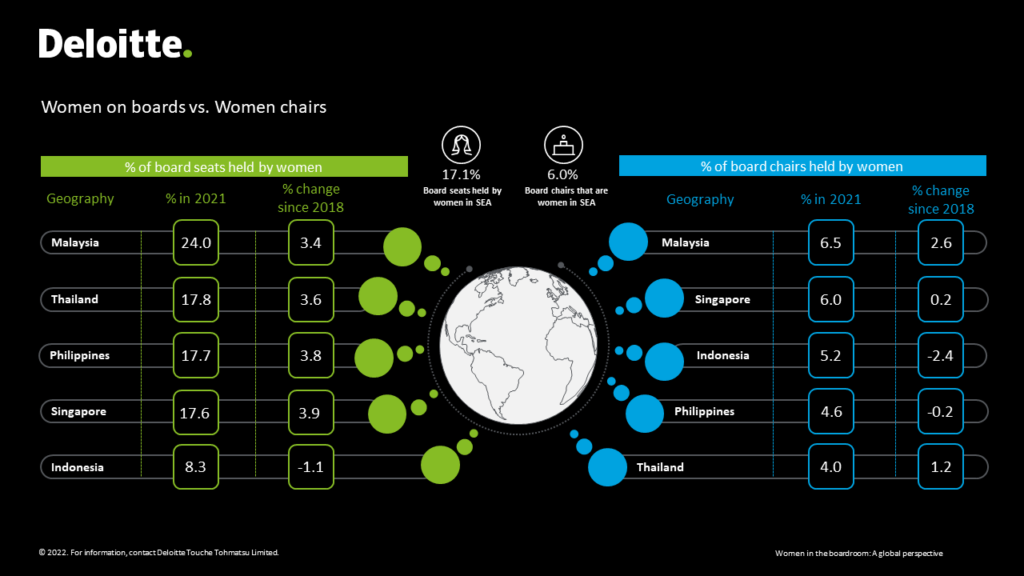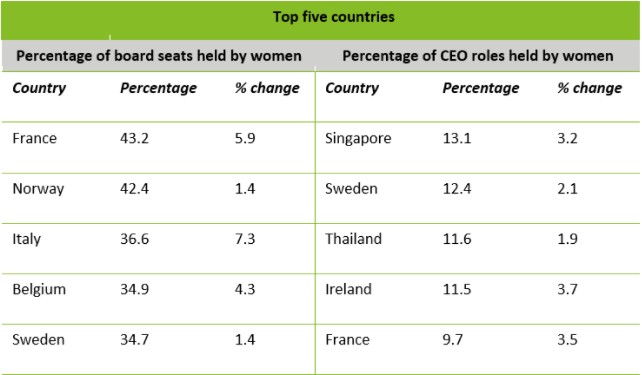Less than a month from International Women’s Day, the Women in the boardroom: A global perspective reveals that women hold just 19.7% of board seats globally, a 2.8% increase from the report’s last edition, published in 2019.
The numbers game
- Southeast Asia closes in with an average of 17.1% of board seats held by women – an increase of 2.7% since 2018, still lower than the global average of 19.7%
- The report reveals a disconnect between women holding roles on boards and in the executive. Only 6.7% globally and 5.3% in Southeast Asia of board chairs are women
- Companies with women CEOs have significantly more balanced boards than those with male CEOs—33.5% vs. 19.4%, respectively
- Singapore reports the highest percentage of women CEOs globally
- All eight major regions (North America, Latin and South America, the Caribbean, Africa, Europe, Middle East and North Africa, Asia, and Australasia) have at least 10% of board seats occupied by women
At the rate change is happening, the report estimates that we will reach near-parity in 2045 – sad but still better than the 2052 predicted by the previous edition of the series.
Disproportionate progress
While global female board representation increased slightly in 2021, progress at the chair and CEO levels are less apparent, underscoring the notion that placing more women on corporate boards does not necessarily equate to progress across leadership positions.
The latest research found that only 6.7% of board chairs are women, representing just a 1.4% increase from 2018. Even fewer women – 5%– hold the CEO role, representing only a 0.6% increase from 2018.
On the bright side, the research revealed a positive correlation between female CEO leadership and board diversity. Companies with women CEOs have significantly more women on their boards than those run by men—33.5% vs. 19.4%, respectively.
The statistics are similar for companies with female chairs (30.8% women on boards vs. 19.4%, respectively). The inverse is true as well, with gender-diverse boards more likely to appoint a female CEO and board chair.
Progress in Southeast Asia

In terms of percentage change, the region reported a 2.7% increase from 2018 which is consistent with the 2.8% increase globally. Malaysia (3.4%), the Philippines (3.8%), Singapore (3.9%) and Thailand (3.6%) reported better percentage increases, surpassing the global figure, while Indonesia saw a 1.0% decline.
The research showed polarising results where even though 6.0% of board chairs are women in Southeast Asia, the percentage change is more widely dispersed. Most significantly, Indonesia saw a negative 2.4% chance, and Malaysia and Thailand reported positive 2.6% and 1.2% changes respectively.
For comparison, when looking at CEO roles held by women, Singapore (13.1%) and Thailand (11.6%) are ranked first and third respectively among the countries surveyed.

Countries in Southeast Asia included in this report are Indonesia, Malaysia, the Philippines, Singapore, Thailand and Vietnam, and they have collectively fared better with an average of 17.1% of women in board seats compared to 14.3% in 2018. This outperforms the Asia average of 11.7% and is closing in on the global average of 19.7%.
These findings reinforce that while women’s participation in boards in the region has gone up since 2018, the perception and perhaps the acceptance of women assuming top leadership positions in boards are significantly varied across geographies.

The tenure of women in board seats in Southeast Asia has either remained stable or saw a decline, with the average tenure having decreased most sharply in Singapore, from 5.0 years to 4.4 years. The percentage change for tenure term has also decreased for Malaysia and the Philippines, which could be due to the wider pool of women candidates in these countries given that the overall women participation on boards has increased.
“2022 could be a year of opportunity for the appointment of more women on boards as companies re-evaluate the needs of their board in a post-pandemic business climate,” says Seah Gek Choo, Centre for Corporate Governance Leader, Deloitte Southeast Asia.
She opined that institutional support, in areas like equal pay and flexible work arrangements, and mentorship and sponsorship programs for women are critical to accelerating the progress of having more women in leadership.
Continuing challenges ahead
Deloitte Global’s Stretch Factor metric examines how many board seats an individual holds in a particular market. The higher the stretch factor, the greater the number of board seats the same director occupies in each market.
- In 2021, the Stretch Factor for women increased slightly from the 2018 figure of 1.26 to 1.30, indicating that - compared to men - a smaller group of women are taking on many board seats. Men, by comparison, have a Stretch Factor of 1.17.
- Countries with the highest Stretch Factor for women—Australia (1.43), the US (1.33), and New Zealand (1.32)—have all eschewed quotas in favor of voluntary approaches such as non-binding targets. Meanwhile, those European countries that were early adopters of quotas have much lower Stretch Factors for women directors, some equal to that of men globally.
- In Southeast Asia, the stretch factor is 1.17 for women, which is an increase from 2018, meaning that women are now occupying more, and multiple, directorships in the region.





